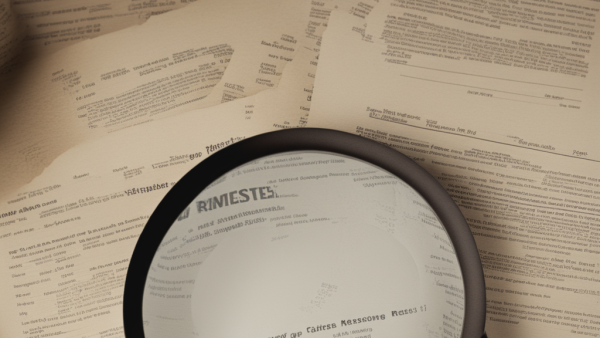
by Sam Franklin | October 01, 2022 | 31 min read
Warehouse setup guide: Setting up an efficient small warehouse
Get fundedLast updated: October 06, 2022
If you are planning to set up a warehouse to store your products or third-party products from manufacturers and wholesalers, you probably have more questions than answers.
Setting up an efficient warehouse can be challenging, especially if it's your first time and you don’t know the procedures to follow.
This article provides an in-depth warehouse setup guide to make the whole process hassle-free for you.
Table of contents
- Four basic functions of a warehouse
- Components of a warehouse
- Other parts of a warehouse
- What’s a warehouse layout design, and why is it important?
- Benefits of having a warehouse layout design
- Four processes to keep in mind when designing your warehouse layout
- Other factors to consider when designing your warehouse layout
- How to design and set up your warehouse layout
- Types of warehouse layout
- Challenges of warehouse layout design
- Tips on setting up an efficient small warehouse
- Warehouse layout best practices
- Warehouse layout design checklist
- Warehouse design FAQs
- Final thoughts on warehouse setup
Four basic functions of a warehouse
A warehouse is a large space used to store goods and materials temporarily as they move from one vendor to another or from a vendor to the final consumer.
Business entities that utilise warehouses include importers, exporters, wholesalers, and manufacturers.
The four main functions of a warehouse include:
1. Storage
Storage is the primary function of a warehouse. Businesses utilise warehouses to store equipment, raw materials, finished products, packaging materials, safety stock, and machine components.
A warehouse facilitates storage for such inventory from purchase or production until they are needed for use or sale. As a business owner, a warehouse helps you keep your stock safe and prevent the wastage of materials.
There are two types of storage in a warehouse:
Planned storage - this involves carefully estimated timelines to meet customer demand.
Extended storage - this involves prolonged storage due to demand seasonality and speculative purchase.
2. Security
A warehouse not only stores your goods but also ensures they are safe and secure. Goods stored in a warehouse are safe from losses due to theft, vandalisation, or damage caused by unfavourable weather conditions.
Since the storage conditions within a warehouse are regulated, goods that are sensitive to dust, wind, heat, cold, or moisture are also well cared for. Perishable goods are often stored under cold storage facilities within the warehouse to secure them from going bad.
Additionally, warehouses are guarded by security personnel to protect your goods from theft and fire-fighting equipment to prevent fire accidents. If your business premises cannot secure your inventory sufficiently, the best option is to hire warehouse storage or set up your small warehouse.
3. Value addition
A warehouse provides value addition to optimise supply chain management. Examples of value-addition services that take place in a warehouse include:
Repacking - re-sizing product packages or changing the packaging according to market requirements.
Re-branding and grading - re-branding and grading products on behalf of the wholesaler.
Re-processing - making certain goods more consumable for the end user, e.g. facilitating ripening of fruits and processing of coffee.
Bundling and customisation - customising and bundling products to suit specific market needs.
Warehouses perform these services on behalf of the product owner at a fee. As a business owner, this takes the burden of performing such activities off your shoulder and allows you to focus on your business's core activities.
4. Prize stabilisation
A warehouse helps you deal with violent price fluctuations to shield your business from suffering losses resulting from demand and supply.
For instance, you can store your goods for longer when the supply in the market exceeds demand, which often causes prices to fall. Similarly, you can release the goods when demand rises again since the prices will also go up.
Warehouses, therefore, ensure a steady supply of goods by matching demand with supply, thus helping to stabilise market prices.
Components of a warehouse

An ideal warehouse is strategically designed to make it easy for all the above functions to operate seamlessly. It should also promote the flow of goods from one place to another without commotion.
Consequently, there are five major components of a warehouse: receiving area, dynamic storage, static storage, shipping area, and staging area.
1. The receiving area
Every warehouse has a receiving area where incoming packages are handled before storage. When an incoming truck arrives with goods to be stored, the warehouse staff unload the goods at the receiving area, unbox, and inspect them to determine whether they are suitable for storage.
They also record the items received and verify whether it is what they expected before taking them for storage. For instance, they check the type of products, the quality, and the quantity against expectations.
2. The static storage area
Storage is the primary function of a warehouse. Once products are received into the warehouse, they should be safely stored in specific storage areas to maximise space utilisation. The static storage area stores all products with a specific storage space allocated to them within the factory.
Storage spaces within this area are marked with the product names and items organised on racking systems. Items stored in static storage rarely move around unless they are going for shipment.
3. The dynamic storage area
This storage area holds items with no fixed storage allocation within the factory. These items are often in high demand and regularly move into and out of the warehouse.
The dynamic storage area is often allocated close to the parking area to minimise the regular movement of goods. It accommodates different contents at different times due to changing demand for products in the market.
4. The shipping area
This area is used to store outgoing products that are ready for pick-up. The shipping area is where the warehouse staff pack materials, load them into trucks and make them ready for delivery to the customer.
5. The staging area
This is where goods received are temporarily kept — often on the floor since there are no racks here — before they are transported to their specific storage areas. The staging area gives the warehouse staff ample time to record all the items received and plan for their proper storage.
Other parts of a warehouse
Aside from the four main components mentioned, other parts of a warehouse support its operations and make the working environment conducive for the warehouse personnel.
Though not directly related to the product flow, they promote smooth business operations within the warehouse. They include:
The offices: There should be a dedicated office space with office desks, file cabinets, and computers where administrative activities occur. This space can also be used for phone calls, meetings, and other warehouse management activities.
Returns: A distinguished space used to segregate and process returned products. These products should never be mixed with other products in the storage — they should be received, inspected, and put away separately.
Restrooms and break rooms: Restrooms are part of the OSHA requirements for any work environment. For a small warehouse with less than 15 workers, one restroom is enough. The warehouse staff also need a space for tea breaks, lunch, or to relax during off-work hours, which is paramount to job satisfaction.
Warehouse maintenance room: A warehouse maintenance room is also necessary for keeping tools used for maintenance and replacement parts. These tools are used to repair damages and for continuous maintenance to keep the warehouse running.
What’s a warehouse layout design, and why is it important?
Before setting up your warehouse, you’ll need to produce an elaborate warehouse layout design to help you execute the process effectively.
What’s a warehouse layout design?
A warehouse layout design is the planned physical design and makeup of the interior and exterior of a warehouse. It also outlines the immediate areas surrounding the actual building. It provides the roadmap you’ll use when setting up your warehouse to avoid unforeseen setbacks.
An ideal warehouse layout design should promote the efficient flow of goods and maximum productivity.
Benefits of having a warehouse layout design
Some of the benefits of having an elaborate warehouse layout design include:
Enhances warehouse management
When the warehouse design promotes smooth operation, all your warehouse activities will run efficiently, and the warehouse becomes easy to manage.
A warehouse layout design gives you the big picture of how to manage the operations such that:
Inventory is well organised and stored appropriately
The movement of goods is easy and fast
Stock is replaced quickly
Orders are fulfilled rapidly
Staff have a conducive working environment
Optimises space utilisation
The main objective of having a warehouse layout is to optimise the available space and make it sufficient for all the intended functions. Optimising warehouse space reduces the time taken to handle goods within the warehouse. It also helps to organise inventory in a way that streamlines every stage of operation.
With a well-designed layout, you can ensure that every inch of the warehouse is optimised to achieve its full potential and no space goes wasted.
Maximises productivity
An elaborate warehouse layout design ensures maximum productivity and speeds up order fulfilment. This is because it’s easy to identify where specific goods are stored within the warehouse and requires less time to move them from one area to another.
When inventory management is smooth and efficient, productivity is maximised, and business grows fast.
Effective allocation of resources
An efficient warehouse layout helps you allocate resources more effectively. For instance, you can tell how many employees you’ll need to hire in every section of the warehouse and allocate a budget even before setting up the warehouse.
The layout can also enable you to estimate a budget for regular warehouse cleaning and maintenance.
Promotes a clean and tidy environment
A warehouse should always be kept clean and tidy to maintain the condition of the goods. Keeping it tidy also helps avoid the misplacement or mishandling of items within the warehouse or items.
With a good warehouse layout design, you’ll ensure everything sits in its place to minimise damage, misplacement, and mix-ups.
Four processes to keep in mind when designing your warehouse layout
The two main factors you need to consider when designing your warehouse layout are functionality and efficiency.
Your warehouse should be designed in a way that enables it to perform all its intended functions efficiently at all times. When designing, consider how to fit all the inventory and optimise the space for maximum productivity.
To achieve this, you need to consider four processes when designing the warehouse layout: inventory receiving and stowing, warehouse picking, inventory tracking, and shipping.
1. Inventory receiving and stowing
This is the process of receiving products into the warehouse for storage. It involves offloading products from the truck, verifying receipt, and moving them to their designated storage areas.
The inventory receipt process should be organised to avoid issues related to stock control and prevent costs like damage during offloading. The receipt area should allow the warehouse staff to inspect the goods before moving them to storage.
Factor in space for equipment such as forklifts, trolleys, and pallet jacks which facilitate the movement of goods to the storage areas.
For storage, you should consider the size, weight, and type of products to be stored when designing the storage space layout. Goods in a warehouse can be stored in shelves, pellets, or bins depending on their types, size, and weight.
2. Inventory tracking
Inventory tracking is a critical part of warehouse management. As a business owner, you’ll need to implement an inventory tracking system to help you track available, incoming, and outgoing stock. Manually tracking inventory is not only hectic and inefficient but also time-wasting.
While designing your warehouse layout, identify the inventory management software you’ll use to enable real-time tracking. This will ensure your warehouse always has enough stock to meet market demand.
Efficient inventory tracking will make your warehouse more efficient and set your business up for success.
3. Warehouse picking
Warehouse picking is another process that needs to be smooth and effortless.
When designing your warehouse layout, keep in mind various factors that affect the picking process. Some of those factors include:
Generation of the picking list
The distance between picking and lading
How to locate the items to be picked
The picking criteria to be used: batch picking, zone picking, discrete picking, or wave picking.
The design of the picking process will determine how quickly the warehouse team can pick and release items for shipping without compromising quality, accuracy, and efficiency.
4. The inventory shipping
Your warehouse team is responsible for packing goods appropriately, preparing them for shipping, and loading them into the shipping trucks.
The shipping process must be designed to promote accuracy and efficiency. It should also allow simultaneous loading and shipping of different types of products or large volume orders.
Choose the right carrier service to partner with, whether domestic, regional, or international. The carrier service will help you with shipping and order fulfilment if you can’t handle it all alone. Your carrier partner will largely depend on the location of your warehouse and the shipping distances.
Remember to initiate order tracking once you release the goods to keep your customers updated on their deliveries.
Other factors to consider when designing your warehouse layout
In addition to the processes outlined, there are other factors you’ll need to consider when designing an efficient layout for your small warehouse.
Some significant factors to consider include the available space, products, personnel, equipment, flow, and accessibility.
Space
The physical dimensions of the warehouse must be accurately reflected in your layout design. This information will be necessary to help you allocate units accurately within the warehouse.
When allocating space, give the maximum space to storage and stock processing while minimising space for associated functions like office work, restrooms, and empty pallets storage.
Due to improvements in modern storage materials, you can maximise small storage space to hold a large amount of inventory. With storage equipment like pallet racks and cantilever racks, you don’t need to worry about space limitations when establishing your small warehouse.
Product
Another factor to consider is the type of products to be stored in your warehouse and their characteristics.
The main factors to consider about your products include:
The load unit
The dimensions
Minimum and maximum weights
Perishability
Sensitivity to different conditions, e.g. cold temperatures
These factors will determine the type of storage equipment you’ll install, the storage conditions, and the dimension of storage shelves.
Personnel
The warehouse staff will make a critical part of your facility.
When designing the layout, keep in mind the number of employees working in the warehouse, their training level and organisation level, their working shifts, and their work interactions.
You’ll also need to consider occupational health and safety standards for the safety of the warehouse staff. With these factors in mind, you’ll design a layout that promotes a safe and conducive working environment for maximum efficiency and productivity.
Equipment
The type of equipment to be used in the warehouse will also significantly affect its design.
Depending on the type of operations, the size, weight, and type of goods to be handled, you can know which equipment you'll need in the warehouse.
Some of the equipment includes workspace equipment like assembly tables and workbenches; movement equipment like trolleys and forklifts; and storage equipment like shelves and pallet racks.
Flow
Flow refers to the logistical movement of goods from receipt to order processing and to dispatch. When designing your warehouse layout, ensure it supports a logical sequence of operations so that each activity takes place as close as possible to the preceding one.
Similarly, the activity should be adjacent to the one that follows. Logical flow ensures uninterrupted movement of materials and personnel within the warehouse, thus minimising traffic and cross-flow clashes.
Accessibility
Your warehouse layout should guarantee a high level of accessibility within the warehouse. Accessibility means being able to get the required product within the minimum time possible. Many warehouse owners use the first-in-first-out (FIFO) criteria to enhance the accessibility of materials.
However, it's not only about accessing the required product but also gathering the right amount of the product. For instance, if you store products in pallets, the design should make it easy for one to access individual pallets and those in a row.
How to design and set up your warehouse layout
Once you know the main components of a warehouse and the processes to keep in mind when designing the layout, setting up your warehouse layout should not be a hard nut to crack.
When you’re ready to start designing, follow this step-by-step guide to design and set up an elegant layout for your small warehouse.
1. Create a visual blueprint
The first step in designing your warehouse layout is to create a blueprint or a visual diagram of how you want your small warehouse to look. No matter the expected size of the warehouse, a 2D visualisation will come in handy in helping you plan.
You can create a warehouse diagram through digital design software or using physical schematics on grid paper. Online layout tools such as SmartDraw have specific features to help you produce a good warehouse design.
Through the schematic diagram, you’ll have a clear picture of the location of various areas, such as the shipping and receiving docks, the static and dynamic storage spaces, and the spatial relationship between these areas.
You’ll also use the diagram to outline the warehouse workflow to ensure that the actual warehouse will be well organised for maximum efficiency.
Remember to take the most accurate measurements of your projected warehouse to minimise errors. When drawing physically on a grid paper, use one square on the grid paper to represent one square foot on your actual warehouse.
Label fixed areas like doors, beams, outposts, sloping floors, offices, and restrooms in your diagram to facilitate spatial planning.
The diagram below shows an example of a completed warehouse layout design drawn on a physical grid paper.

2. Define the workstations
The next step is to define different workstations within the warehouse to optimise space utilisation. However, before defining the workstations, you need to ask yourself whether the warehouse has enough space to accommodate all the essential components while leaving space for employees to work comfortably.
First, you’ll need to calculate your storage area, then allocate space for equipment and various production and workflow zones. Knowing your storage area will help you define the storage capacity of your warehouse and establish limits on how many goods the warehouse can accommodate.
Your storage area is the total square footage of the warehouse minus the offices, restrooms, and any other space not intended for storage.
Identify the workstations you need in your warehouse, and define and label them appropriately on your layout diagram.
All the major areas of the warehouse must be accounted for, including the shipping and receiving areas, storage areas, staging areas, offices, assembly lines, and employee spaces.
3. Pick a suitable workflow
The next step is to think about the workflow—how the warehouse staff, materials, and equipment will move around the key areas of the warehouse.
To choose an appropriate workflow for your warehouse, you’ll need to consider the available warehouse space and implement a design that fits naturally.
There are three basic types of workflow you can choose depending on your space:
The U-shaped warehouse workflow
The I-shaped workflow
The L-shaped workflow
The U-shaped flow will fit you well if you want to have the receiving and shipping areas close enough. The I-shaped workflow is the best for minimising space usage, while the L-shaped workflow is suitable for an L-shaped warehouse.
Another critical factor to consider when selecting an appropriate warehouse workflow is safety. The movement of people, materials, and equipment within the warehouse should minimise safety hazards such as sliding, falling, or colliding.
The Occupational Health and Safety Administration (OSHA) has a detailed warehousing safety guide to help you plan for your warehouse safety initiatives.
We’ll discuss the different types of warehouse workflow later in this guide.
4. Select your equipment
Since a warehouse performs other functions apart from storage, there is various equipment you’ll need to stock in the facility to help with these functions.
For instance, workspace equipment like packing stations is necessary if your warehouse will be doing product repackaging. Other types of equipment you’ll need in the warehouse include:
Workspace equipment: These include assembly tables and workbenches, dedicated packing stations, dedicated shipping station tables, freight scale stations, and speciality manufacturing assembly stations.
Movement equipment: This equipment helps to move goods from one station to another, such as trolleys, forklifts, pallet jacks, conveyors, rolling staircases, and carriage lifts.
Storage equipment: These include shelves (heavy-duty, light-duty, and speciality shelving), storage bins, boxes, hoppers, pallet racks, and cantilever racks.
You don’t need to purchase all the equipment for your small warehouse. The type of equipment you choose will depend on the operations to be carried out in the facility, the size, weight, and types of goods expected, and the workflow you choose for your warehouse.
Write down a list of the warehouse equipment you’ll need and plan on purchasing them. You can get most of them from big importers like Amazon and Alibaba.
5. Test your warehouse plan
The next step is to test the warehouse plan to see whether it will work flawlessly without compromising efficiency and productivity.
Before installing equipment and working tables, you’ll need to test the traffic flow and make observations for any necessary changes.
Use masking tape to mark the floor and demarcate the units within the warehouse. Mark the positioning of the major storage areas, the equipment, storage shelves, and workstations.
After marking, conduct a mock test as if you’re moving goods around or performing designated functions like packing. Involve the warehouse staff or friends in the test, and let them act out the work processes.
Observe the ease of movement of staff, materials, and equipment and identify stations that may need adjustment for higher efficiency. It’s better to adjust the traffic flow at the design stage than wait until equipment is installed to start moving it around.
When the layout planning and testing processes are successful, you can rest assured that your warehouse setup will promote safe, efficient, and cost-effective operations to maximise profitability.
6. Gather feedback
The last step is to gather employee feedback. If you involve your employees in the traffic flow test, let them tell you what they think about the layout and suggest any adjustments that will make the operations easier.
After gathering their feedback, review the layout design and implement the necessary changes. Employees are in the best position to identify opportunities that promote better workflow and minimise human errors in warehouse operations.
7. Implement a Warehouse Management System
A warehouse management system (WMS) is one of the most effective ways to run a successful warehouse.
After setting up your warehouse, you want to automate the operations by implementing a robust WMS that will make inventory tracking and record keeping a walk in the park.
A warehouse management system helps to:
Increase accuracy in operations
Minimise the errors in a manual system
Promote timely replenishment of inventory
Saves time and effort used in warehouse management
Types of warehouse layout
When building and setting up a new warehouse from scratch, there are three major layouts you can adopt, depending on the available space and the operations expected to take place in the warehouse.
You can choose to build a U-shaped warehouse, an L-shaped warehouse, or an I-shaped warehouse. Each of these layouts has its advantages and disadvantages, as explained below:
The rule of thumb is to have the inbound and outbound loading docks in separate positions.
The U-shaped warehouse
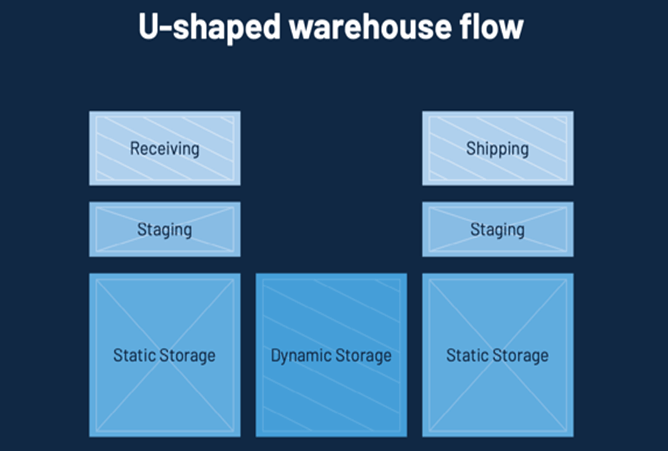
U-shaped warehouses are the most common warehouse types where the layout takes the shape of a semicircle. The inbound loading docks and the outbound loading docks are on parallel sides, while the storage and picking areas are at the centre of the warehouse.
A U-shaped warehouse is the best layout for a small warehouse since it makes operations flow effortlessly. It effectively separates traffic flow within the warehouse and streamlines the movement of materials and personnel.
With the inbound and outbound loading on parallel sides, you can avoid unnecessary bottlenecks that cause confusion and errors in operation. The U-shaped flow maximises warehouse space and allows goods to move quickly from receipt to shipping.
However, one setback of the U-shaped warehouse layout is that it can cause congestion since the receiving and shipping trucks often have to pack on the same side of the building. If the packing space is small, you can only handle one truck at a time, either loading or unloading.
The I-shaped warehouse
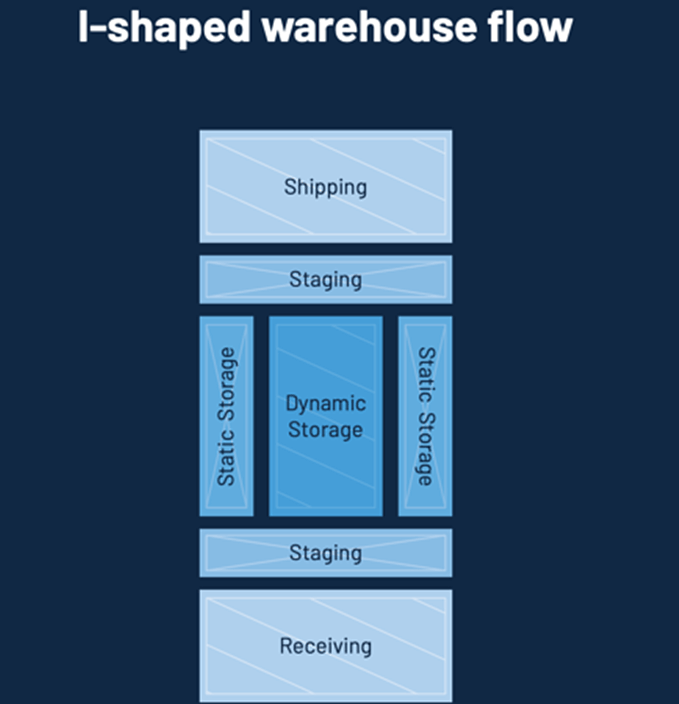
The I-shaped warehouse is the simplest warehouse layout, also known as a through-flow layout.
This layout takes the shape of a rectangle with the inbound loading dock on one end and the outbound loading dock on the opposite end of the rectangle. The storage space is often in the middle of the rectangle.
Most large corporations adopt the I-shaped layout for their big warehouses due to their high production volume and frequent inflow and outflow of goods. In this layout, goods move from the receiving area to the shipping area in a straight-line flow.
The advantage of the I-shaped warehouse is that it optimises warehouse space by ensuring the entire warehouse area is utilised. It also limits back and forth movement of goods, thus minimising bottlenecks.
The I-shaped layout may not be suitable for small warehouses since it requires optimal space for loading and unloading areas. You may also need to purchase separate loading equipment for the inbound and outbound loading bays due to the distance apart, which may be expensive for a beginner.
The L-shaped warehouse
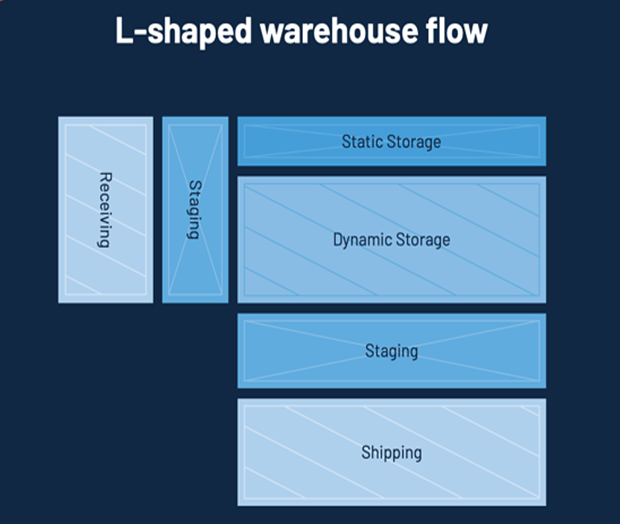
The L-shaped warehouse is an uncommon warehouse layout in which the inbound and outbound docks are on adjacent sides at a 90-degree angle, and goods move in an L-shaped flow. The storage area is located at the corner of the L-shape.
Like the I-shaped layout, this layout minimises back and forth movement of goods and effectively controls congestion. However, it does not optimise space, and a lot of space is needed for a smooth traffic flow in the L-shaped warehouse layout.
When choosing the type of warehouse layout to set up, keep all the intended functions in mind while considering the available space. Always remember to account for future growth so you won’t have to redesign when the business starts growing.
Challenges of warehouse layout design
Aside from its benefits, designing a warehouse layout also has its challenges. You should, therefore, anticipate and have a plan to address these challenges when designing your warehouse layout.
Some of the challenges include:
Safety precautions
Safety precautions should always be part of the layout design process. Every section of the warehouse should leave ample space for the safe movement of the warehouse personnel. Equipment should also be allowed to move in a way that does not hurt the personnel.
Other safety precautions to consider include allocations for fire safety equipment and a maintenance room for storage of maintenance equipment. Many layout designers forget to include these safety precautions and have to redo the layout later.
Over-utilising space
While designing your warehouse layout, you may find yourself trying to over-utilise a small area. This is dangerous as it can cause overcrowding and misplacement of goods.
Overcrowded warehouse space also compromises safety since personnel are likely to experience injuries.
Underutilising space
Underutilisation of warehouse space is also a common challenge with the design layout. Every space within the warehouse should be utilised for a specific purpose without over-squeezing.
Underutilisation will reduce cost efficiency and the overall productivity of your warehouse.
Planning for the future
Your warehouse layout should be flexible and ready to adapt to future changes. This can be a challenge, especially when setting up a small warehouse, since you don’t have ample space to spare for the future.
However, you can still save specific shelving areas to cater to predicted inventory fluctuations.
Tips on setting up an efficient small warehouse
Here are more tips to help you set up specific components of your warehouse in a way that promotes efficient workflow and enhances productivity:
The receiving dock (inbound loading bay)
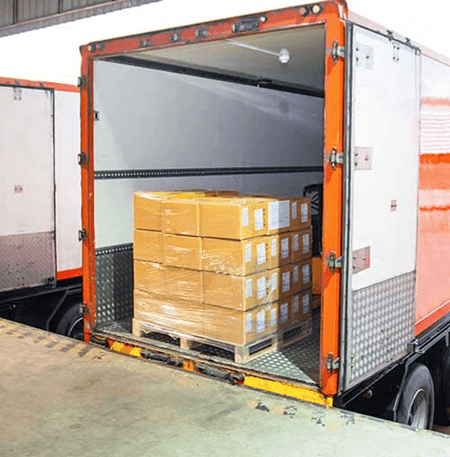
The receiving dock is where trucks are offloaded and goods are received into the warehouse.
Consider the following when setting up the receiving dock for your small warehouse:
Have a large packing area to allow large trucks to turn and park easily near the loading bay.
Lay out the receiving dock height such that it’s in line with the bed height of the delivery vehicles most commonly used to deliver goods to the warehouse.
Allocate a holding space near the loading bay where received goods can temporarily stay before they are cleared for storage.
Allocate a small office space close to the receiving area where the warehouse manager will conduct associated activities such as sampling and inspecting the goods received, checking the invoices, and allocating permanent storage space for the goods.
The storage area
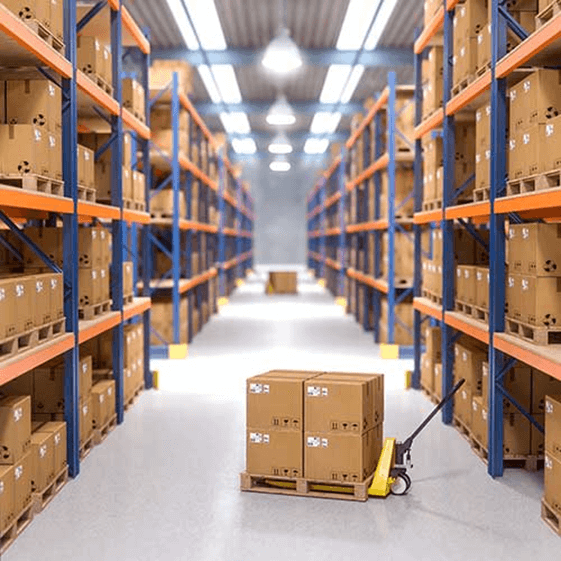
Most parts of the warehouse will be dedicated to the storage of goods. In terms of cubic feet, the storage area should occupy 22-27% of the total area of the warehouse.
Implement the following tips when setting up the storage space for maximum efficiency:
Use pallet racks and industrial shelving to make maximum use of the clear height by storing more goods vertically.
Utilise a reliable warehouse management system to assign storage locations and maximise the warehouse space.
Make sure the aisles are wide enough to allow smooth movement of pallet jacks and forklifts.
Install adequate lighting in the storage area for good visibility of goods during picking.
Inventory picking
The picking area is where goods are retrieved from storage and made ready for shipment to the customer. The order pickers receive the list of items to be picked for fulfilling customer orders and locate these items from the storage.
The following tips will help you set up an efficient picking area for your warehouse:
Locate the picking area as close to the storage area as possible.
Make extra space for storage of picking equipment like pallet jacks, roller conveyors, and forklifts.
Use shopping carts or shopping baskets to pick smaller items that do not need large equipment, like forklifts.
The shipping area

Items picked are taken to the shipping area, where they are packaged for order fulfilment. The shipping area should also be as close as possible to the storage and picking locations for easy flow of goods. Here are some layout tips for your shipping area:
Set up shipping stations with packing tables and all shipping supplies at the shipping area where your staff will package the goods for shipping.
Put aside space for stocking the shipping boxes and your inventory of shipping supplies.
Set another space for order staging where you keep orders that are ready for shipping and await loading into the trucks.
Outbound loading bay
The outbound loading bay is the exit point where goods ready for shipment are loaded onto the shipping trucks.
The loading bay floor should be the same height as the truck beds for easy loading of goods into the trucks.
Ensure proper ventilation at the loading bay to cater to the exhaust fumes released by idling trucks.
Set apart enough space for loading equipment like pallet jacks, dock ramps, and pallet wrap machines.
Organise the shipment by carrier type to make the shipping process easier to track and manage.
Warehouse layout best practices
The difference between an ordinary warehouse and a highly efficient and successful warehouse is in the details. How many extra miles are you willing to go to make your small warehouse of a higher standard?
Here are some warehouse layout best practices to help you set up a super standard warehouse:
Define clear goals
Define your goals and objectives before starting to design the layout. What do you hope to achieve with your warehouse? Do you want to fasten order fulfilment or simply facilitate large-scale storage?
Defining the objectives includes setting key performance indicators, which confer with other goals of the supply chain. It will also ensure that the warehouse layout supports your company’s specific goals and vision.
Label shelves and items
Put labels on every storage shelf or pallet to improve organisation and avoid confusion. Labelling ensures that every incoming item is correctly placed and reduces time wasted in retrieving items from the storage area.
Train the warehouse staff
Before the warehouse starts operating, ensure the employees are well trained and know what’s expected of them. Develop a training process to help them understand the process flow and what should be done at every stage, from receipt to shipping.
Training your staff will give them confidence in handling warehouse activities and help avoid inefficiency due to personnel ignorance.
Implement an inventory tracking technique
Inventory tracking helps you know how many products you have in the warehouse and how much more you can accommodate. While you can use manual tracking for a start, it gets hectic with time, and automated tracking becomes the best option.
Some inventory tracking methods you can use include spreadsheets, order cards, a barcode system, or cloud-based inventory management software. Inventory software is the most accurate and hassle-free way to track your inventory.
Implement warehouse automation
The easiest way to eliminate human errors and keep warehouse operations running smoothly is through a warehouse management system.
An automated WMS will help you organise the warehouse, monitor the movement of goods, manage staff productivity, and coordinate the receipt and shipping process.
Statistics show that 77% of companies are currently using automated WMS to maximise data-proven performance.
Warehouse layout design checklist
As you can see, there’s so much involved in planning and setting up an efficient warehouse. Without sufficient precaution, it’s easy to forget the nitty gritty that impacts cost efficiency and smooth functioning.
Here are some questions you can use as a checklist to help you design a more efficient warehouse layout.
Is your warehouse optimised for workflow?
Does it minimise the distance between storage, picking, and shipping?
Does it promote a logical flow of materials?
Does it have a defined order picking strategy?
Does the warehouse leave enough room for future growth?
Is the space well utilised, both horizontally and vertically?
Will the storage space allow the re-organisation of packing racks in the future?
Is there ample space to accommodate product influx?
Is the space flexible to scale?
Does the warehouse accommodate equipment appropriately?
Is there enough space for equipment storage?
Is the equipment easily accessible?
Do the isles provide sufficient space for equipment movement?
Can the forklifts turn around safely?
Are employees well-considered in the layout?
Can the employees move around safely?
Does the design minimise safety risks?
Does it minimise overcrowding and obstruction?
Warehouse design FAQs
Setting up a warehouse involves more than just drawing a layout and buying the necessary equipment. Here are the answers to some frequently asked questions related to warehouse design:
Why do we need to lay out a warehouse?
You need to lay out a warehouse to optimise space utilisation and promote effective allocation of resources. A warehouse layout ensures maximum productivity and efficient flow of operations and promotes cleanliness and tidiness.
What is the best warehouse layout?
The U-shaped warehouse is the best for beginners. This layout promotes space maximisation and keeps traffic flow separate. The movement of products between the receiving and shipping areas is easy, and the parallel positioning of inbound and outbound loading minimises bottlenecks.
How do you organise a warehouse layout?
To efficiently organise a warehouse layout, space out the loading and unloading area, organise the storage areas appropriately and separate the picking area. Also, demarcate the packing area and adjust the reception and shipping areas accordingly.
What are the principles of good warehouse layout?
The basic principles of a good warehouse layout include efficiency, accuracy, cost control, accessibility, safety, and high performance.
Why is warehouse planning important?
Warehouse planning increases the efficiency of the warehouse setup process and minimises associated errors. Careful planning will also help you reduce storage costs and speed up order fulfilment while maintaining accuracy.
Final thoughts on warehouse setup
Regardless of the size, there’s so much involved in setting up an efficient warehouse. The warehouse setup process starts from planning to designing the layout and implementing the best practices for optimum functionality.
If you’ve read through the entire warehouse setup guide, you now have what it takes to design an efficient warehouse layout and set up your small warehouse. Remember to cooperate with the supply chain so that your goals and objectives align with related departments within your organisation.
Written by

Sam founded his first startup back in 2010 and has since been building startups in the Content Marketing, SEO, eCommerce and SaaS verticals. Sam is a generalist with deep knowledge of lead generation and scaling acquisition and sales.


